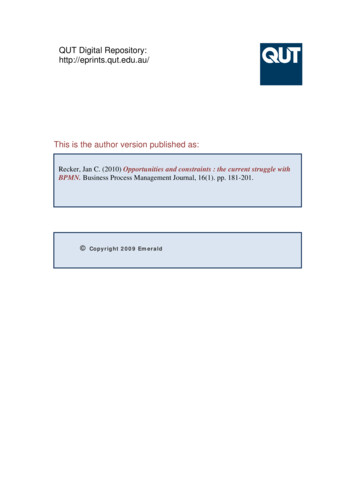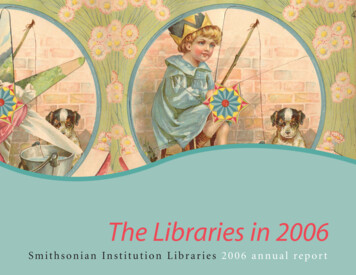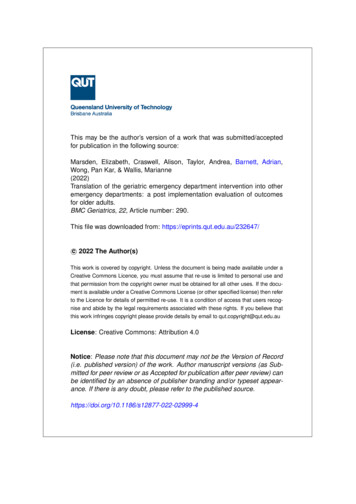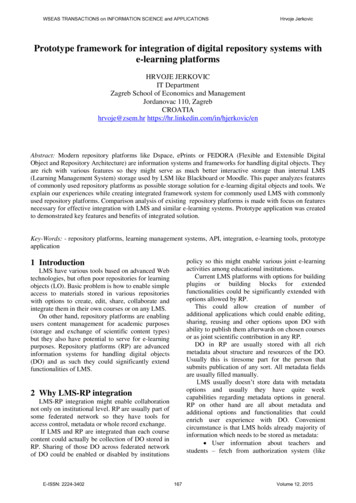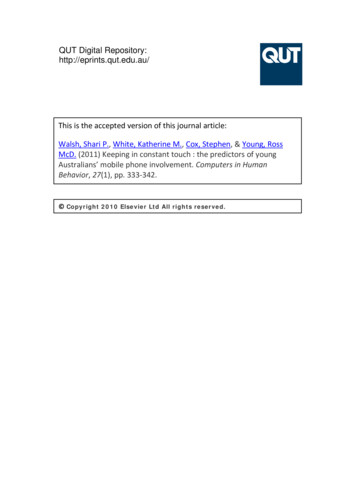
Transcription
QUT Digital Repository:http://eprints.qut.edu.au/This is the accepted version of this journal article:Walsh, Shari P., White, Katherine M., Cox, Stephen, & Young, RossMcD. (2011) Keeping in constant touch : the predictors of youngAustralians’ mobile phone involvement. Computers in HumanBehavior, 27(1), pp. 333‐342. Copyright 2010 Elsevier Ltd All rights reserved.
Mobile phone involvementRUNNING HEAD: Mobile phone involvementKeeping in Constant Touch: The Predictors of Young Australians’ Mobile PhoneInvolvementShari P. Walsh1Katherine M. White1Stephen Cox2Ross McD. Young31School of Psychology and CounsellingQueensland University of TechnologyVictoria Park RoadKelvin Grove, Qld, Australia 4059sp.walsh@qut.edu.aukm.white@qut.edu.au2Faculty of BusinessQueensland University of Technology2 George StreetBrisbane, Qld, Australia 4000sd.cox@qut.edu.au3Institute of Health and Biomedical InnovationQueensland University of Technology60 Musk AvenueKelvin Grove, Qld, Australia 40591
Mobile phone involvementrm.young@qut.edu.auAll correspondence concerning this manuscript should be addressed to:Assoc Prof Katherine White, School of Psychology and Counselling, ,University of Technology, Kelvin Grove, Queensland, 4059, Australia.Email: km.white@qut.edu.au ; Phone: 61 7 3138 4689 ; Fax: 61 7 3138 04862
Mobile phone involvementAbstractLittle is known about the psychological underpinnings of young people’s mobilephone behaviour. In the present research, 292 young Australians, aged 16 to 24 years,completed an on-line survey assessing the effects of self-identity, ingroup norm, the needto belong, and self-esteem on their frequency of mobile phone use and mobile phoneinvolvement, conceptualised as people’s degree of cognitive and behavioural associationwith their mobile phone. Structural equation modelling revealed that age (younger) andself-identity significantly predicted the frequency of mobile phone use. In contrast, age(younger), gender (female), self-identity and ingroup norm predicted young people’smobile phone involvement. Additionally, a trend suggesting that the role of self-esteemon mobile phone involvement was related to participants’ need to belong was identified.The present study contributes to our understanding of this phenomenon and provides anindication of the characteristics of young people who may become highly involved withtheir mobile phone.Keywords: Australia; identity; mobile phone; motivations; youth;3
Mobile phone involvementKeeping in Constant Touch: The Predictors of Young Australians’ Mobile PhoneInvolvement.Since their introduction over 20 years ago, mobile phones have become highlyprevalent with youth, in particular, adopting mobile phones as an integral part of theirdaily lives. Young Australians’, aged in their late teens to mid twenties, are more likelythan any other demographic group to use their mobile phones to communicate with othersby calling and text messaging and also for additional functions such as downloadingmusic, taking photographs, and accessing the internet to watch sport (Access Economics,2008; Australian Communications and Media Authority [ACMA], 2007). Theseadditional functions have moved mobile phones from being telecommunication tools tomobile computers, increasing the popularity of these technological devices (ACMA,2007). Additionally there are a number of psychological benefits arising from mobilephone use including enhanced connectivity facilitating social inclusion (Peters & benAllouch, 2005; Wei & Lo, 2006); feelings of safety due to rapid contactability should anemergency occur (Carroll, Howard, Peck, & Murphy, 2002; Pain et al., 2005); andenabling workers to remain contactable by employers and clients (Eost & Flyte, 1998).In addition to the acknowledged benefits of mobile phone use, however, youngpeople’s involvement with their mobile phones is leading to some problematic outcomes.For instance, the presence and use of mobile phones in schools and other educationalinstitutions (for example, universities and colleges) is disruptive and reduces students’attention in class (Hiscock, 2004; Selwyn, 2003); debt from mobile phone use is anincreasing problem for many young people, leading to financial hardship and, in somecases, bankruptcy (Australian Communications Authority, 2004; Griffiths & Renwick,4
Mobile phone involvement2003); and young people frequently use mobile phones while driving, a widelyacknowledged unsafe driving practice (Pennay, 2006; Walsh, White, Hyde, & Watson,2008). Determining the factors influencing young people’s mobile phone involvementwill assist in understanding the development of patterns of mobile phone behaviourwhich may result in negative outcomes.Previous mobile phone research has primarily assessed the frequency that peopleuse their mobile phones for calling and text messaging (e.g., Ozcan & Kocak, 2003;Walsh & White, 2006, 2007). However, these measures may not adequately gauge theextent of people’s interactions with their mobile phone given that using mobile phones asmobile computers is becoming more widespread (ACMA, 2007) and that some peopleare cognitively pre-occupied with their phone when not using it. For instance, youngpeople report thinking about their mobile phone when not using it, being distracted fromother tasks when they have their phone with them, and prominently displaying the phonekeeping it constantly in their awareness (Walsh & White, 2006; Walsh, White, & Young,2008). These activities indicate that mobile phone behaviour incorporates both cognitiveand behavioural aspects, conceptualised by Walsh, White, and Young (in press) asmobile phone involvement.Walsh et al. (in press) posit that mobile phone involvement represents a person’scognitive (such as the extent to which a person thinks about their mobile phone when notusing it) and behavioural (such as constantly checking the mobile phone for missedmessages or calls) association with their mobile phone. Thus, mobile phone involvementis a broader construct than frequency of use due to its encapsulation of both the cognitiveand behavioural aspects of mobile phone behaviour. Similar to highly engaged computer5
Mobile phone involvementusers (Charlton & Danforth, 2004) and other behavioural addictions (Orford, 2004),people who are involved with their mobile phone may not always be frequent or highusers of the technology due to the cognitive component of the construct. Mobile phoneinvolvement is similar to a behavioural addiction but without pathologisingconsequences. Nevertheless, characteristics of addiction are posited to underlie mobilephone involvement and form the foundation of the Walsh et al.’s (in press) measurementtool and for the investigation of young people’s mobile phone behaviour in the presentresearch.Recent literature has drawn on addiction symptoms to measure problematic(Bianchi & Phillips, 2005), compulsive (James & Drennan, 2005), heavy (Jenaro, Flores,Gomez-Vela, Gonzalez-Gil, & Caballo, 2007), intensive (Sanchez-Martinez & Otero,2008), maladaptive (Beranuy, Oberst, Carbonell, & Chamarrow, 2009), dependent(Billieux, Van der Linden, d'Acremont, Ceschi, & Zermatten, 2007) and addictivetendencies for (Ehrenberg, Juckes, White, & Walsh, 2008; Walsh, White, & Young,2007) mobile phone use. However, some conceptual and methodological issues havebeen identified in some of these studies. For instance, Bianchi and Phillips’ (2005)measure of problematic mobile use included items assessing social influences, such ashow much friends used a mobile phone, which may have confounded results. In Jenaro etal.’s (2007) study mobile phone over-use was categorised as a pathological behaviourwhilst Beranuy et al. (2009) use the term maladaptive, classifications which may bepremature as it is not yet clear that negative outcomes of mobile phone use are severeenough to warrant the behaviour being diagnosed as a pathological condition. Otherstudies have either not reported scale items (Sanchez-Martinez & Otero, 2008); or have6
Mobile phone involvementassessed some, but not all, of the proposed indicators of addiction (Ehrenberg et al., 2008;Walsh et al., 2007). These studies, however, indicate that it is younger people whosemobile phone behaviour is most likely to resemble an addictive pattern of behaviour. Forthis reason, this study focussed on a youth cohort. Additionally, problematic andinappropriate mobile phone use is more likely among young people reporting symptomsof addiction in relation to their mobile phone behaviour (Bianchi & Phillips, 2005; James& Drennan, 2005; Walsh, White, & Young, 2008).In addition to identifying that younger users are most likely to be highly involvedwith their mobile phones and to engage in concerning patterns of behaviour, a number ofinternal and external factors, such as self and social influences respectively, may impacton young people’s mobile phone behaviour. For instance, mobile phones are reportedly aform of self-expressive identity (Mannetti, Pierro, & Livi, 2002; Walsh & White, 2007)with some users incorporating mobile phones into their sense of self (Srivastava, 2005).Additionally, significant others affect young people’s frequency of mobile phone use andalso their type of mobile phone use (Srivastava, 2005; Walsh, White, & Young, 2009)suggesting that social influences, in particular ingroup norms (how much a behaviourallyrelevant reference group engages in the activity), impact on mobile phone behaviour.Finally, some young mobile phone users report having a mobile phone increases theirsense of self-worth as they feel connected to others (Walsh et al., 2009; Wei & Lo, 2006).Thus, psychosocial motivations, such as self-esteem enhancement and the need to belong,may also underlie young people’s mobile phone behaviour. As yet, however, there hasbeen little empirical investigation of the role of these internal and external factors onyoung people’s mobile phone behaviour. Given the pre-dominantly social nature of7
Mobile phone involvementmobile phone use, the present research drew on major concepts in social psychology todevelop a preliminary understanding of the role of psychosocial factors in determiningyoung people’s mobile phone behaviour.It is acknowledged that there may be a number of alternate theoretical approacheswhich may be utilised to investigate mobile phone behaviour. However, the relativelynew nature of research in this domain has not allowed for a coherent theoretical model tobe developed. Thus, the present research drew on earlier research, in particular qualitativestudies, to identify variables for examination in this study. Specifically, the researchassessed the effect of self-identity, ingroup norm, self-esteem, and the need to belong onyoung people’s mobile phone behaviour as a preliminary examination of factors that mayinfluence this behaviour.Self-identityAs opposed to mobile phone involvement which focuses on the psychological andbehavioural interactions a person has with their phone, self identity reflects the value ofthe behaviour (in this case, mobile phone use) to a person’s self-concept. According toidentity theory, self-identity is formed when externalised roles and behaviours andinternal characteristics such as goals, moral concerns, values, and affective components,become incorporated into the self-concept (Gergen, 1971; Stryker, 1987). One methodthat people use to express their self-identity is by the ownership and use of materialobjects, particularly objects which represent social status, personality, and a person’sattitudes and values (Dittmar, 1992). Young people seek out and use material objectswhich both symbolise their identity and enhance their emotional state (Dittmar, 2005;8
Mobile phone involvementDittmar, Long, & Bond, 2007). Behaviours which are highly salient are subsequentlyintegrated into an individual’s self-identity (Gergen, 1971).Mobile phone use is a highly salient part of many young people’s daily livessuggesting that being a mobile phone user has become integrated into many youngpeople’s self-identity (Walsh, White & Young, 2008). Additionally, young peoplepersonalise their mobile phones with unique ring-tones and screen-savers (e.g., Baron &Ling, 2007; Goggin, 2006; Katz & Sugiyama, 2005) and believe mobile phonessymbolise their growing independence from their parents (Ling, 1999) and theirindividuality (Campbell & Yong, 2008). The adoption of mobile phones as a form of selfexpressive identity within this cohort influences both type and frequency of mobile phonebehaviour (Mannetti et al., 2002; Walsh & White, 2007) suggesting that mobile phoneshave become a materialistic representation of the self. Thus, a number of processesappear to have led to mobile phones becoming a valued part of young people’s selfidentity such that some young mobile phone users cannot imagine life without theirmobile phone and view their mobile phone as an appendage (Walsh, White & Young,2008).Although self-identity has been found to predict frequency of mobile phone use(Walsh & White, 2007; Walsh et al., in press) and high involvement with mobile phonesamongst Australian youth (Walsh et al., in press), it is important to assess the relationshipbetween self-identity and other potential influences on young people’s mobile phonebehaviour. Adolescents and young adults are at a life-stage in which they are developingtheir identity in a wider social context (Smetana, Campione-Barr, & Metzger, 2006) withthe influence of their friends and peers leading to performance of potentially addictive9
Mobile phone involvementbehaviours (Orford, 2001; Piko, 2006). Thus, social influences, such as ingroup norms,are also likely to impact on young people’s mobile phone behaviour.Ingroup NormsAccording to the social identity theory/self-categorisation perspective, the self andbehaviour is socially constructed when salient group memberships become incorporatedinto a person’s identity (Hogg & Abrams, 1988; Turner, 1991). By monitoring groupprocesses people form evaluations about their role within the group and their place in thegroup hierarchy. When people feel valued as a group member they incorporate sharedintra-group characteristics into their self-concept so that they conform to group standardswith ingroup norms subsequently becoming the reference point for beliefs, attitudes, andbehaviours (Hogg & Abrams, 1988; Turner, 1991). Whilst social influence is most likelyto influence behaviour under conditions when the group is present, internalisation ofperceived norms influences behaviour in contexts removed from the group presence(Ellemers, Spears, & Doosje, 2002) particularly when the group is highly salient (White,Hogg, & Terry, 2002) or if the approval of others is important to the person’s sense ofself-worth (Crocker & Wolfe, 2001).Young people, in particular, are influenced by the behaviour of other groupmembers (Smetana et al., 2006), and, as such, ingroup norms may be a particularlyimportant influence on mobile phone behaviour in this cohort. Mobile phones provideconstant connection to others potentially increasing the psychological relationship thatpeople have with their friends and peers (Walsh et al., 2009; Wei & Lo, 2006). Althoughthe link between social identity processes and mobile phone use is yet to be establishedempirically, Cassidy (2006) argues that mobile phone use is positively viewed within10
Mobile phone involvementyoung people’s social groups and that this perception influences the uptake and frequencyof mobile phone use by young people. Additionally, young people have reported thatnormative influences impact on the purchase of their mobile phone and that groupbehaviour dictated, in part, which type of mobile phone use (calling or text messaging)became their preferred communication method (Walsh et al., 2009). Although this effectmay also be related to personality factors, such as neuroticism and extraversion, it is theimportance of maintaining peer relationships which has been found to be highlyinfluential on young people’s mobile phone behaviour (Igarashi, Motoyoshi, Takai, &Yoshida, 2008). Thus, ingroup norms appear to be related to young people’s mobilephone behaviour and, as such, will be explored further in this study. In addition tomaintaining group memberships, young people actively seek out new relationships whichenhance their psychological well being (Smetana et al., 2006). Thus, social motivationsmay also influence young people’s mobile phone behaviour.Social Motivations: Belonging and Self-esteemBehavioural motivations arise from a complex interaction of the individual’sneeds, desires and concerns, contextual and situational variables, and stimulus attributes(Pittman, 1998). People actively choose why, when, and how to behave according to theirmost salient motivation (Fiske, 2002; Ruggiero, 2000) and seek out the most effectivedevice or behaviour to fulfil this need (Pittman, 1998). Social motivations, in particular,impact on social behaviours (see Fiske, 2002).Of the five commonly agreed social motives, shared understanding, control, trust,self-enhancement (or maintaining self-esteem), and belonging (Fiske, 2004), it isbelonging and self-esteem which are potentially most relevant to mobile phone11
Mobile phone involvementbehaviour. Belonging, a need for strong stable interpersonal relationships (Baumeister &Leary, 1995), is posited to be the most fundamental social motivation which underpinsthe other four motives (see Fiske, 2002). To enhance belonging, people seek out frequentcontact with others and cultivate personal relationships so that they feel connected to, andvalued by, other people (Baumeister & Leary, 1995). Belonging is posited to promoteself-esteem and psychological well-being whilst a lack of belonging is related to poormental health and low self-esteem (Baumeister, 1991).Self-esteem, or an individual’s perception of their value or worth as a person, isimportant for overall psychological health, resilience and coping (Baumeister, Tice, &Hutton, 1989; Rosenberg, 1965). Young people’s self-esteem is often related to theirrelationships with, and feedback from, friends and peers (Arnett, 2004; Rosenberg, 1965)particularly if their self-worth is contingent on approval from others (Crocker & Wolfe,2001). As mobile phones are valued for providing connection to others, self-esteem mayimpact on young people’s mobile phone behaviour. To date, however, investigations ofthe effect of self-esteem on mobile phone use have produced mixed results. Whilst someauthors found that low self-esteem predicted problematic (Bianchi & Phillips, 2005) andexcessive mobile phone use (Ha, Chin, Park, Ryu, & Yu, 2008), other authors found norelationship between self-esteem and amount of mobile phone use (Butt & Phillips, 2008;Ehrenberg et al., 2008; Phillips, Butt, & Blaszczynski, 2006) or mobile phone addictivetendencies amongst youth (Ehrenberg et al., 2008). Thus, the relationship between selfesteem and mobile phone behaviour remains unclear. It may be, however, that rather thandirectly influencing mobile phone behaviour, the effect of self-esteem on mobile phoneuse is mediated by one’s need to belong.12
Mobile phone involvementA relationship between belonging and self-esteem, in the context of mobile phoneuse, was revealed in a study investigating ostracism from text message conversations(Smith & Williams, 2004). Participants who were excluded from SMS conversationsreported reduced levels of belonging and lower self-esteem (Smith & Williams, 2004).This trend has also been found when young people perceive that they are not beingincluded in contact between members of their social group (Charlton, Panting, & Hannan,2002). As low self-esteem is believed to result in a stronger need to belong (Baumeister& Leary, 1995), these findings suggest that the effect of self-esteem on young people’smobile behaviour may be mediated by the need to belong. The present research exploredthese relationships to further our understanding of the interaction between self-esteemand need to belong in the context of young people’s mobile phone behaviour.The Present ResearchAlthough there is a growing body of mobile phone research conducted from apsychological perspective, our understanding of social psychological factorsunderpinning young people’s mobile phone behaviour is limited. The present research,then, sought to develop a model representing the psychosocial predictors of both thefrequency of mobile phone use and mobile phone involvement amongst Australian youth,aged between 16 and 24 years. Specifically, the research assessed the effect of selfidentity, ingroup norm, self-esteem, and the need to belong on both young people’sfrequency of mobile phone use and mobile phone involvement which represents aperson’s cognitive and behavioural association with their mobile phone (Walsh et al., inpress). Based on previous research, the following hypotheses were proposed:13
Mobile phone involvementIt was expected that self identity, ingroup norm, and need to belong would eachpredict frequency of mobile phone use and mobile phone involvement respectively(Hypothesis 1). Specifically, it was believed that young people who reported high levelsof self-identity, ingroup norm, and the need to belong would be more likely to use theirphone more frequently and report a higher degree of involvement with their mobilephone. It was proposed also that a negative relationship would be found between selfesteem and the need to belong with young people who reported low self-esteem beingmore likely to report a stronger need to belong (Hypothesis 2). Finally, in an exploratorymanner, it was expected that the effect of self-esteem on young people’s frequency ofmobile phone use and the degree of their mobile phone involvement would by mediatedby the need to belong (Hypothesis 3).In addition to including psychological variables in the model, the demographicfactors of age, gender, and mobile phone payment method were assessed to control forthe effect of these factors on young people’s mobile phone behaviour. Explicithypotheses were not formulated in relation to these demographic variables. In the firsttest of the proposed model, paths were specified between these demographic factors andthe outcome measures of frequency of mobile phone use and mobile phone involvementto control for their effects.MethodDesignThe study was a cross-sectional design with participants completing an onlineself-report survey. The outcome measures were frequency of mobile phone use andmobile phone involvement. The predictor variables were self-identity, ingroup norm,14
Mobile phone involvementneed to belong, self-esteem, and there were three control variables, age, gender, andpayment method.Participants and ProcedurePrior to commencement of the study, ethical approval was obtained from theuniversity’s Human Research Ethics Committee. Participants were recruited by postinginformation on various online youth news-lists (for example, youthGAS a website whichadvertises events for young people and people who work with themhttp://www.youthgas.com/), and sending emails to youth organizations (such as churchyouth groups), high schools and universities throughout Australia for distribution to theirmembers and students. The online postings and emails explained the purpose of the studyand provided a link to a website specifically created for the research project. Due to theuse of third parties to advertise the survey, it was not possible to ascertain how manyadvertisements were distributed online or the number of young people who receiveddetails of the study.The front page of the survey website outlined the study and included agescreening criterion (“Are you aged between 16 and 24 years?”). Participants whoanswered ‘yes’ to the screening criterion were then able to access the survey site. Uponcompletion of the survey, participants were directed to another website where theyprovided their contact details in order to be entered into a draw to win one of five 20(AUD) shopping vouchers. To protect participants’ anonymity, this data file was unableto be linked to the data file containing their survey responses. All contact details weredeleted once the prize draw was conducted. Data collection occurred in October toDecember 2007 with the website closed upon completion of the data collection period.15
Mobile phone involvementIn total, 303 participants entered the survey site during the 3 month data collectionperiod. However, as the primary data analysis technique, structural equation modelling, isnot effective with missing data, 11 cases with missing data were removed. In total, datafrom 292 (males 30%, females 70%) Australian youth aged between 16 and 24 years (M 20.22, SD 2.50) were analysed representing a completion rate of 97.3%. Youth fromall states in Australia took part in the study.MeasuresThe questionnaire assessed demographic information, frequency of mobile phoneuse, mobile phone involvement, self-identity, ingroup norm, need to belong, and selfesteem. Reversed items were included throughout the questionnaire to overcome thepotential for response bias.Demographics. Participants selected their age, gender, and mobile phone paymentmethod (pre-paid versus not pre-paid) from pre-determined categories.Frequency of mobile phone use. Participants indicated the average number of callsmade, calls received, text messages read, and text messages received each day in fouropen-ended questions. These items were then summed to create a scale reflecting theaverage frequency of use per day (α .68).Mobile phone involvement questionnaire (MPIQ). The eight-item Mobile PhoneInvolvement Questionnaire developed by Walsh et al. (in press) assessed participants’cognitive and behavioural association with their mobile phone. Based on Brown’s (1997)behavioural addiction components and qualitative descriptions of mobile phonebehaviour (Walsh, White & Young, 2008), the MPIQ includes items measuringwithdrawal, cognitive and behavioural salience, euphoria, loss of control, relapse and16
Mobile phone involvementreinstatement, conflict with other activities, and interpersonal conflict, specificallyworded to relate to mobile phone behaviour. Example items are “I often think about mymobile phone when I am not using it”, “Arguments have arisen with others because ofmy mobile phone use”, and “I lose track of how much I am using my mobile phone”.Items were scored 1 strongly disagree to 7 strongly agree. Summing and averaging theitems resulted in a moderately reliable scale (α .80).Self-identity. Three items adapted from Terry, Hogg and White (1999) assessedself-identity, or the value of a behaviour to a person’s self-concept, in the context ofmobile phone use. Items included “Being a mobile phone user is an important part of whoI am”, scored from 1 strongly disagree to 7 strongly agree. A moderately reliable scale (α .81) was formed by summing and averaging the items.Ingroup norm. Two items (adapted from Terry & Hogg, 1996) assessed ingroupnorm, or the level to which a behaviourally relevant reference group performs thebehaviour. An example item is “Mobile phone use is common amongst my friends andpeers”; scored 1 strongly disagree to 7 strongly agree. Items were summed and averagedforming a moderately reliable scale (α .80)Need to Belong Scale. The 10-item Need to Belong Scale developed by Leary etal. (Leary, Kelly, Cottrell, & Schreindorfer, 2007) assessed the strength of people’s desirefor relationships with others, for example “I need to feel that there are people I can turn toin times of need”; scored 1 not at all to 5 extremely. Items were summed and averaged toform a moderately reliable measure (α .74).Rosenberg Self-Esteem Scale. The Rosenberg Self-Esteem Scale (1965), a 10item measure, assessed global self-esteem. An example item is “On the whole, I am17
Mobile phone involvementsatisfied with myself”; scored 1 strongly disagree to 4 strongly agree. Items weresummed and averaged to form a reliable scale (α .89).Data AnalysisPrior to the commencement of data analysis, reversed items which were includedto reduce response bias were subsequently recoded so that all scale items were in thesame (positive) direction. Additionally, the open-ended responses in the frequency of usemeasures were converted to numerical data (e.g., four 4). Descriptive statistics wereobtained for participants’ demographic information and their self-reported level of mobilephone use. Bivariate correlations assessed the overall relationships between the variablesin the study. Path modelling using AMOS 16 was then employed to assess therelationships between the predictor variables and the outcome measures.The specified model included two outcome measures, frequency of mobile phoneuse and mobile phone involvement (see Figure 1), to enable the relationships between thepredictors and both outcome variables to be assessed in the one analysis. The modelallowed both outcome measures to be predicted by the four psychological variables andthe three control variables. Additionally, need to belong was predicted by self esteem.Finally, all exogenous variables, (i.e., the controls and the psychological variablesexcluding need to belong) were allowed to covary. Model parameters were estimated bythe maximum likelihood method and a number of indicators were used to assess the fit ofthe model. For a satisfactory fit, the chi-squared test should be non-significant (Kline,2005). Additional indices used to evaluate the model fit were the Comparative Fit Index(CFI) and the Root Mean Square Error of Approximation (RMSEA). For a moderatemodel fit, the CFI should be above .90 and the RMSEA below .08 (Marsh, Balla, & Hau,18
Mobile phone involvement1996). The predictive ability of the model was evaluated by inspecting the pathcoefficients and R2 values.ResultsDescriptive StatisticsExamination of d
Mobile phone involvement 1 RUNNING HEAD: Mobile phone involvement . 2Faculty of Business Queensland University of Technology 2 George Street Brisbane, Qld, Australia 4000 sd.cox@qut.edu.au 3Institute of Health and Biomedical Innovation Queensland University of Technology 60 Musk Avenue Kelvin Grove, Qld, Australia 4059 .
